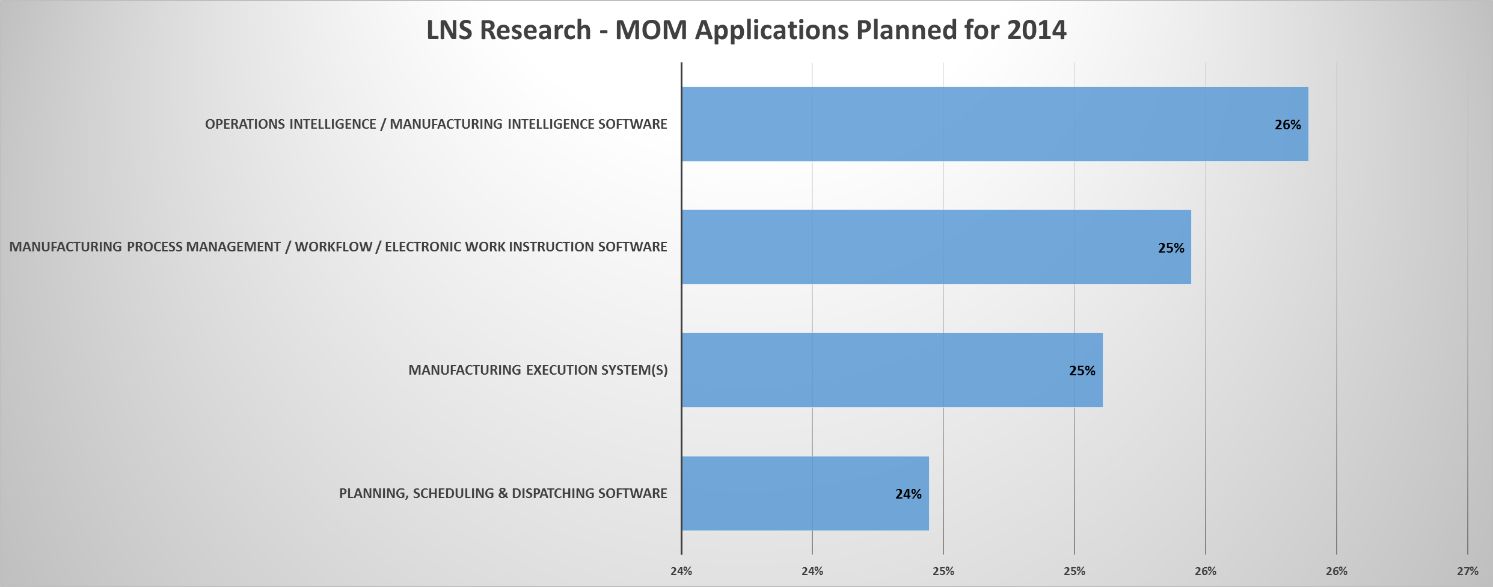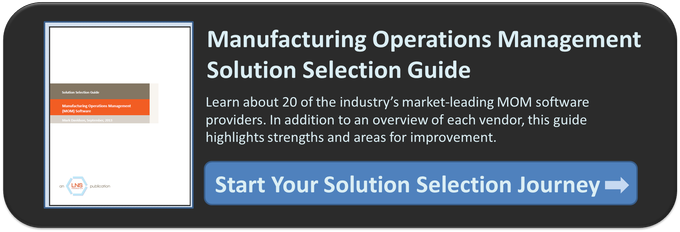We saw new signs of lively activity in the world of Manufacturing Operations Management (MOM) software solutions this past year, due to several factors, not the least of which was the beginnings of economic recovery in developed regions of the world. This activity is also attributable to growth in demand from an expanding middle class in emerging market areas of the world, as well as from shifts in manufacturing locations with re-shoring activities, a global environment of stable energy prices, and new technology advancements delivering benefits that are too compelling to ignore.
Empowering knowledge workers and successfully capturing their long-held knowledge and experience is a key opportunity area for higher manufacturing productivity and performance in 2014. Software solutions that help to better organize work processes and manage large amounts of data into actionable information will flourish.
As part of LNS Research’s MOM survey work last year, we have a direct indication of which “knowledge applications” will be most adopted during this new year. As part of that survey, we asked which MOM applications were currently implemented, planned within one year, and not yet planned. With over 260 respondents, the top currently implemented MOM applications were: Quality Management, Planning & Scheduling, Document Management, Manufacturing Execution Systems (MES), and Data Historians.
The chart below shows the results of the 2013 MOM survey - indicating the applications that were being planned within one year (i.e. Planned for 2014):
.png?width=674&height=265&name=mom_apps_2014(2).png)
We can see that the top four planned applications for 2014 are Operations/Manufacturing Intelligence (26%), Workflow (25%), MES (25%), and Planning & Scheduling (24%). Each of these applications has been proven to contribute to knowledge workers’ productivity and performance.
- Operations/Manufacturing Intelligence software delivers timely and in-context performance information.
- Workflow software ensures operational procedures and provides knowledge workers with step-by-step guidance, instruction, and information capture.
- MES systems enforce product recipes, manufacturing bills of materials, and combinations of automated and manual procedures—all while tracking products, components, and associated labor activities.
- Planning & Scheduling software assists plant and production managers with how to handle the dynamics of responding to changes in supply and demand.
5 MOM Technology Predictions for 2014
So what are the new technologies that LNS Research sees as positively impacting the way in which solutions will be delivered to help manufacturing workers better organize their work processes and manage large amounts of data into actionable information?
- Mobile Devices: In 2014 cloud-based mobile infrastructures and more native mobile “apps” will be available and used by front line production personnel and management alike. Tablets and smartphones will be used to keep actionable information at everyone’s fingertips, as well as ensuring that all knowledge workers can participate in business and manufacturing process workflows—no matter where they are located. These mobile devices will increasingly become location aware and present relevant information to operations, maintenance and other professionals as they move from plant to plant, and production asset to production asset.
- Big Data & Analytics: With intelligent devices and Ethernet networking causing an explosion of available data, 2014 should be a transition year from “Big Talk” to “Big Reality.” Software vendors as well as in-house IT departments are working hard to develop simpler, faster solutions for harnessing this growing giant. We expect to see more “off-the-shelf” products and point solutions coming this year.
- Cloud-Computing & Software as a Service (SaaS): As servers and software services continue to become virtual and move off-premise, the contrasting total cost of ownership and maintenance requirements make the cloud a viable option for many manufacturing applications. The cloud has transformed the way companies and individuals communicate and collaborate. And distributed facilities, suppliers, and partners that were once disconnected can now easily sync in at the click of a button. Virtualization is the first step towards cloud-computing, and virtualization is already being supported by most MOM applications and vendors. But keep an eye out for the continued rise of SaaS business models for manufacturing applications. We are seeing more and more SaaS offerings from vendors and our research shows that 17% of companies are planning to move this way in the future for their manufacturing applications.
- Connected Devices: You can’t read any recent online or print stories relating to future manufacturing technology without seeing something about the Internet of Things (IoT) or Internet of Everything (IoE). Connected devices are rapidly making their way into businesses, homes, and even personal wear - everyone’s excited about it. The links between people, machines, and the environment are only becoming stronger and the business world is poised to have even more data than it knows what to do with. As everything and everyone becomes more connected, we will see new software solutions that contextualize all of this data into useful information and workflows that better coordinate across both the animate and the inanimate. Look for new software models and standards to be created for this area in 2014.
- Software Platforms & Modular Apps: Despite the benefits of an integrated, harmonized enterprise and manufacturing IT architecture, many companies are still working with disconnected systems and multiple, fractured software architectures. Consequently, achieving the levels of communication and collaboration needed to compete today can be a resource-intensive undertaking. In 2014, we expect to see more progress in next-generation, enterprise-wide MOM software platforms that are analogous to ERP. We should come to expect functionality that makes integration with other enterprise systems and data sources less costly. You can also expect to see more modular manufacturing “apps” being deployed, instead of large monolithic systems and inter-dependent applications. These newer, simplified "apps" will rely on MOM platform services as their common infrastructure.
Effectively Selecting and Leveraging the Right MOM Applications
As manufacturing companies look to get the most and the best from their most valuable asset—their people—2014 should be a year of accelerated new technology adoption. A range of 16% to 26% of manufacturing professionals surveyed have plans for a variety of new MOM software applications as the year progresses. This is a clear indicator of the convincing role that technology has on supporting manufacturing Operational Excellence initiatives.
The bar continues to rise for the achievement of ever-higher levels of productivity and performance in order to compete on both the regional and global stages. In 2014, LNS Research believes that investments in new technology for increased competitiveness should be seen as a necessity, especially at a time when experienced talent and associated knowledge is rapidly retiring. It’s time empower our greatest assets, and capture their tribal knowledge into sustainable MOM software solutions.
